3. Wahl D, Cogger VC, Solon-Biet SM, Waern RV, Gokarn R, Pulpitel T, Cabo R, Mattson MP, Raubenheimer D, Simpson SJ, et al. Nutritional strategies to optimise cognitive function in the aging brain. Ageing Res Rev. 2016; 31:80–92. PMID:
27355990.

5. Ogama N, Yoshida M, Nakai T, Niida S, Toba K, Sakurai T. Frontal white matter hyperintensity predicts lower urinary tract dysfunction in older adults with amnestic mild cognitive impairment and Alzheimer's disease. Geriatr Gerontol Int. 2016; 16:167–174. PMID:
25613527.

6. Lee JS, Kang MJ, Nam HJ, Kim YJ, Lee OJ, Kim KO. Korean Dementia Observatory 2019. Seoul: National Institute of Dementia;2019. p. 3–81.
7. Kim YJ, Han JW, So YS, Seo JY, Kim KY, Kim KW. Prevalence and trends of dementia in Korea: a systematic review and meta-analysis. J Korean Med Sci. 2014; 29:903–912. PMID:
25045221.

8. Pinto C, Subramanyam AA. Mild cognitive impairment: the dilemma. Indian J Psychiatry. 2009; 51(Suppl 1):S44–S51. PMID:
21416016.
9. Eshkoor SA, Hamid TA, Mun CY, Ng CK. Mild cognitive impairment and its management in older people. Clin Interv Aging. 2015; 10:687–693. PMID:
25914527.
10. Middleton LE, Yaffe K. Promising strategies for the prevention of dementia. Arch Neurol. 2009; 66:1210–1215. PMID:
19822776.

11. van de Rest O, Berendsen AA, Haveman-Nies A, de Groot LC. Dietary patterns, cognitive decline, and dementia: a systematic review. Adv Nutr. 2015; 6:154–168. PMID:
25770254.

12. Kant AK, Schatzkin A, Graubard BI, Schairer C. A prospective study of diet quality and mortality in women. JAMA. 2000; 283:2109–2115. PMID:
10791502.

13. Kim JY, Yang YJ, Yang YK, Oh SY, Hong YC, Lee EK, Kwon O. Diet quality scores and oxidative stress in Korean adults. Eur J Clin Nutr. 2011; 65:1271–1278. PMID:
21712839.

14. Yang SJ, Kwak SY, Jo G, Song TJ, Shin MJ. Serum metabolite profile associated with incident type 2 diabetes in Koreans: findings from the Korean Genome and Epidemiology Study. Sci Rep. 2018; 8:8207. PMID:
29844477.

15. Willett WC, Sacks F, Trichopoulou A, Drescher G, Ferro-Luzzi A, Helsing E, Trichopoulos D. Mediterranean diet pyramid: a cultural model for healthy eating. Am J Clin Nutr. 1995; 61(Suppl):1402S–1406S. PMID:
7754995.

16. Wengreen H, Munger RG, Cutler A, Quach A, Bowles A, Corcoran C, Tschanz JT, Norton MC, Welsh-Bohmer KA. Prospective study of Dietary Approaches to Stop Hypertension- and Mediterranean-style dietary patterns and age-related cognitive change: the Cache County Study on Memory, Health and Aging. Am J Clin Nutr. 2013; 98:1263–1271. PMID:
24047922.

17. Abbatecola AM, Russo M, Barbieri M. Dietary patterns and cognition in older persons. Curr Opin Clin Nutr Metab Care. 2018; 21:10–13. PMID:
29035971.

18. Aridi YS, Walker JL, Wright OR. The association between the mediterranean dietary pattern and cognitive health: a systematic review. Nutrients. 2017; 9:674.

19. Solfrizzi V, Panza F, Frisardi V, Seripa D, Logroscino G, Imbimbo BP, Pilotto A. Diet and Alzheimer's disease risk factors or prevention: the current evidence. Expert Rev Neurother. 2011; 11:677–708. PMID:
21539488.

20. Chen X, Maguire B, Brodaty H, O'Leary F. Dietary patterns and cognitive health in older adults: a systematic review. J Alzheimers Dis. 2019; 67:583–619. PMID:
30689586.

21. Kim J, Yu A, Choi BY, Nam JH, Kim MK, Oh DH, Kim K, Yang YJ. Dietary patterns and cognitive function in Korean older adults. Eur J Nutr. 2015; 54:309–318. PMID:
24842708.

22. Shin D, Lee KW, Kim MH, Kim HJ, An YS, Chung HK. Identifying dietary patterns associated with mild cognitive impairment in older Korean adults using reduced rank regression. Int J Environ Res Public Health. 2018; 15:100.

23. Fung TT, McCullough ML, Newby PK, Manson JE, Meigs JB, Rifai N, Willett WC, Hu FB. Diet-quality scores and plasma concentrations of markers of inflammation and endothelial dysfunction. Am J Clin Nutr. 2005; 82:163–173. PMID:
16002815.

24. Lee DY, Lee KU, Lee JH, Kim KW, Jhoo JH, Kim SY, Yoon JC, Woo SI, Ha J, Woo JI. A normative study of the CERAD neuropsychological assessment battery in the Korean elderly. J Int Neuropsychol Soc. 2004; 10:72–81. PMID:
14751009.

25. Kim G, Kim H, Kim KN, Son JI, Kim SY, Tamura T, Chang N. Relationship of cognitive function with B vitamin status, homocysteine, and tissue factor pathway inhibitor in cognitively impaired elderly: a cross-sectional survey. J Alzheimers Dis. 2013; 33:853–862. PMID:
23042212.

26. Milte CM, Ball K, Crawford D, McNaughton SA. Diet quality and cognitive function in mid-aged and older men and women. BMC Geriatr. 2019; 19:361. PMID:
31864295.

27. Ye X, Bhupathiraju SN, Tucker KL. Variety in fruit and vegetable intake and cognitive function in middle-aged and older Puerto Rican adults. Br J Nutr. 2013; 109:503–510. PMID:
22717056.

28. Galioto R, Spitznagel MB. The effects of breakfast and breakfast composition on cognition in adults. Adv Nutr. 2016; 7:576S–589S. PMID:
27184286.

29. Qin B, Adair LS, Plassman BL, Batis C, Edwards LJ, Popkin BM, Mendez MA. Dietary patterns and cognitive decline among Chinese older adults. Epidemiology. 2015; 26:758–768. PMID:
26133024.

30. Hardy JA, Higgins GA. Alzheimer's disease: the amyloid cascade hypothesis. Science. 1992; 256:184–185. PMID:
1566067.

31. Bloom GS. Amyloid-β and tau: the trigger and bullet in Alzheimer disease pathogenesis. JAMA Neurol. 2014; 71:505–508. PMID:
24493463.
32. Vassilaki M, Aakre JA, Syrjanen JA, Mielke MM, Geda YE, Kremers WK, Machulda MM, Alhurani RE, Staubo SC, Knopman DS, et al. Mediterranean diet, its components, and amyloid imaging biomarkers. J Alzheimers Dis. 2018; 64:281–290. PMID:
29889074.

33. Cheignon C, Tomas M, Bonnefont-Rousselot D, Faller P, Hureau C, Collin F. Oxidative stress and the amyloid beta peptide in Alzheimer's disease. Redox Biol. 2018; 14:450–464. PMID:
29080524.

34. Gorelick PB. Role of inflammation in cognitive impairment: results of observational epidemiological studies and clinical trials. Ann N Y Acad Sci. 2010; 1207:155–162. PMID:
20955439.

35. Valls-Pedret C, Sala-Vila A, Serra-Mir M, Corella D, de la Torre R, Martínez-González MÁ, Martínez-Lapiscina EH, Fitó M, Pérez-Heras A, Salas-Salvadó J, et al. Mediterranean diet and age-related cognitive decline: a randomized clinical trial. JAMA Intern Med. 2015; 175:1094–1103. PMID:
25961184.

36. Vasefi M, Hudson M, Ghaboolian-Zare E. Diet associated with inflammation and Alzheimer's disease. J Alzheimers Dis Rep. 2019; 3:299–309. PMID:
31867568.

37. Morimoto SS, Kanellopoulos D, Manning KJ, Alexopoulos GS. Diagnosis and treatment of depression and cognitive impairment in late life. Ann N Y Acad Sci. 2015; 1345:36–46. PMID:
25655026.

38. Seo AR, Kim MJ, Park KS. Regional differences in the association between dietary patterns and muscle strength in Korean older adults: data from the Korea National Health and Nutrition Examination Survey 2014–2016. Nutrients. 2020; 12:1377.

39. Jeong GW, Kim YJ, Park S, Kim H, Kwon O. Associations of recommended food score and physical performance in Korean elderly. BMC Public Health. 2019; 19:128. PMID:
30700281.

40. Kim YJ, Hwang JY, Kim H, Park S, Kwon O. Diet quality, physical activity, and their association with metabolic syndrome in Korean adults. Nutrition. 2019; 59:138–144. PMID:
30471526.

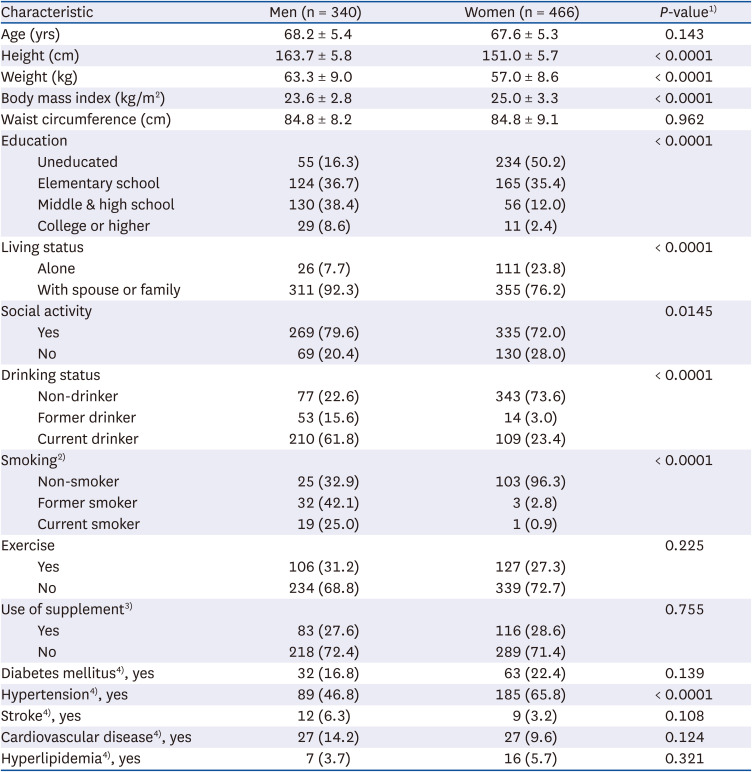
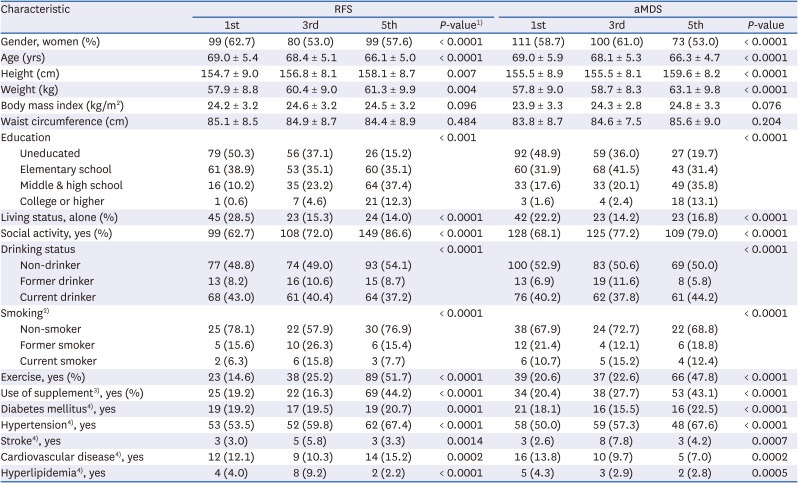
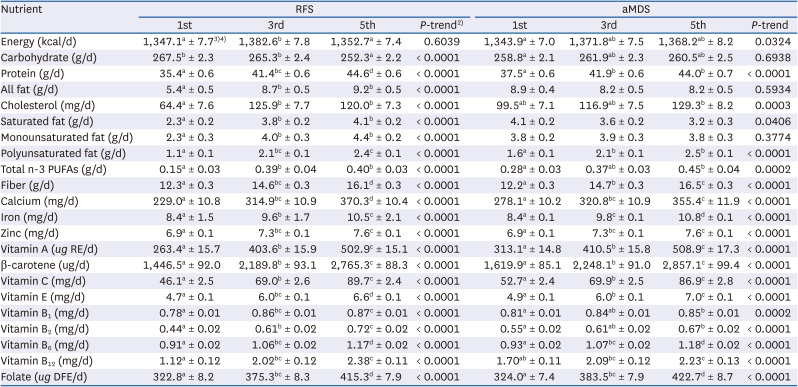
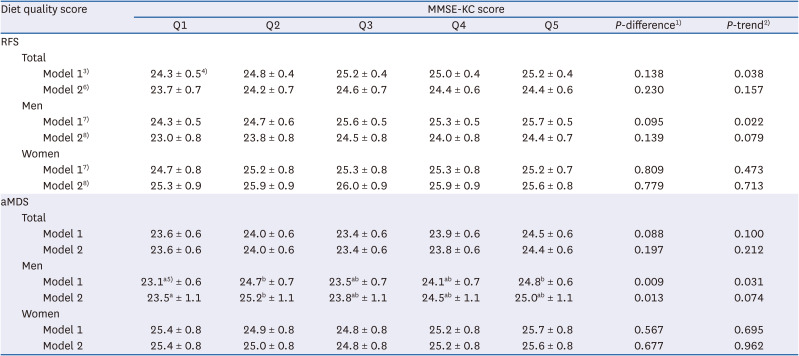
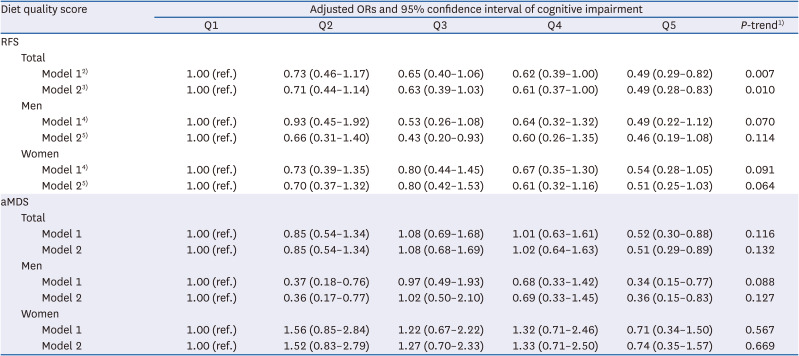




 PDF
PDF Citation
Citation Print
Print



 XML Download
XML Download